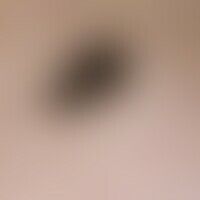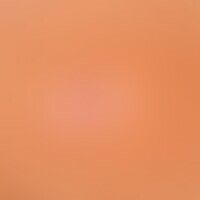Image diagnoses for "Macule"
325 results with 1215 images
Results forMacule

Pemphigoid bullous L12.0
Pemphigoid, bullous. general view: state of healing. Disseminated, sharply defined or confluent, brownish or livid, postinflammatory hyperpigmentation in a 55-year-old female patient.

Nail hematoma T14.05
DD: Nail hematoma - here Melanonychia longitudinalis: Typical finding of a melanocytic pigmentation of the nail. Melanon grows in stripes, starting at the site of pigment formation (here the nail root is not visible) to the front. This finding is not observed in a nail hematoma. Note: the nail matrix shows a dark discoloration at the front edge of the cut (pigment is embedded in the nail matrix).

Erythrasma L08.10
Erythrasma: sharply defined, extensive, non-itching brownish discoloration in the armpit area.

Melanonychia striata L60.8
Melanonychia striata longitudinalis (2): control finding in 2016. widening of the longitudinal pigmentation of the nail plate. clear Hutchinson sign (pigmentation of the nail fold)

Livedo racemosa (overview) M30.8
Livedo racemosa : irregular, bizarre non-closed circle segments, as pioneering morphological indicators of livedo racemosa, and cholesterol embolism occurred in this 73-year-old passon smoker.

Lentigo maligna D03.-
Lentigo maligna: 71-year-old patient, more than five years old, first light brown, then darkened, symptom-free, 1.4 x 0.8 cm, light brown to black-brown spot in actinically stressed skin.

Acrocyanosis I73.81; R23.0;
Acrocyanosis, livid discoloration of the lower extremity, here with pronounced onychomycosis.

Dermatomyositis (overview) M33.-
dermatomyositis: reflected light microscopy. hyperkeratotic nail folds. pathologically enlarged and torqued capillaries. older bleeding into the nail fold.

Nevus melanocytic halo-nevus D22.L

Maculopapular cutaneous mastocytosis Q82.2
Urticaria pigmentosa/progression: patient as before, 10 years later. in the meantime almost extensive infestation due to confluence of the flock. lbaortechnical indications for systemic infestation.

Amiodarone hyperpigmentation T78.9
Amiodarone hyperpigmentation: cyanosis-likeamiodarone hyperpigmentation after long-term application of the preparation due to tachyarrhythmia.

Pityriasis versicolor alba B36.0
Pityriasis versicolor alba: irregularly distributed, symptomless, bright spots, which in places have merged to form larger areas, appearing after repeated exposure to sunlight.

Airborne contact dermatitis L23.8
Airborne Contact Dermatitis: Retroauricular infection: This pattern distinguishes ACD from photoallergic eczema, where the "shadow area of the auricle" remains free.

Mononucleosis infectious B27.9
Mononuleosis, infectious. generalized (almost universal) macular exanthema.

Toxic epidermal necrolysis L51.2
Toxic epidermal necrolysis: incipient extensive necrolytic detachment of the skin.

Idiopathic guttate hypomelanosis L81.5
Hypomelanosis guttata idiopathica: Multiple, chronic, for years increasing, disseminated, mainly at the light exposed areas, preferably localized on the stretching side, 0.2-0.4 cm large, round, symptomless, white, slightly rough spots.

Pityriasis versicolor (overview) B36.0
Pityriasis versicolor: Large and small, slightly scaly, only occasionally slightly itchy, bright, bizarrely shaped spots (Pityriasis versicolor alba).

Extrinsic skin aging L98.8
Light ageing of the skin: spotty skin with small hyperpigmentations (solar lentigines) and actinic keratosis.

Acrocyanosis I73.81; R23.0;
acrocyanosis: typical picture of the red, cold foot in a 42-year-old chain smoker. variable course. erythema not painful. occurs at an ambient temperature of 20ºC and less. also in stressful situations

Dermatomyositis paraneoplastic M33.1

Perioral dermatitis L71.0

Livedoid vasculopathy L95.0
Livedovasculopathy: changes in the sole of the foot (rather rare localization)


